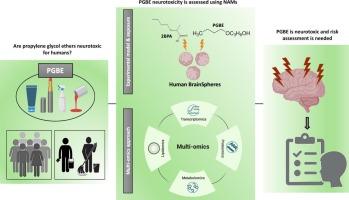Neurotoxicity of propylene glycol butyl ether: Multiomic evidence from human brainspheres
IF 9.7
1区 环境科学与生态学
Q1 ENVIRONMENTAL SCIENCES
引用次数: 0
Abstract
Exposure to solvents may contribute to the development of neurodevelopmental and neurodegenerative diseases. Glycol ethers consist in a widely used class of organic solvents leading to workers and consumers exposure via many applications. Ethylene glycol ethers are gradually being replaced by propylene glycol ethers thought to be less toxic. However, their neurotoxicity is not systematically assessed before placing them on the market. Therefore, this study investigated the potential neurotoxicity of propylene glycol butyl ether (PGBE) for which no official occupational limit has been established. To this aim, new approach methodologies have been used. Human induced pluripotent stem cells-derived BrainSpheres model was exposed to PGBE and to its assumed human main metabolite, 2-butoxypropanoic acid (2BPA). An integrative multiomic approach (transcriptomics, proteomics, metabolomics and lipidomics) was adopted to assess molecular alterations, derive benchmark concentrations and define potential mechanisms of action. PGBE was neurotoxic at occupationally relevant exposure concentrations. This was shown for the first time in human cells. Although PGBE was more cytotoxic than 2BPA, both compounds showed very similar neurotoxicity. PGBE and 2BPA strongly affected the cell cycle, induced oxidative stress and perturbed energy and lipid metabolism. They also targeted specific nervous system processes, such as axon guidance and synapse organization. Finally, 2BPA might trigger ferroptosis by increased iron uptake. Our in vitro results show an urgent need for public health authorities to carefully assess the risk glycol ethers pose to humans, to properly protect the workers as well as individuals in the general population unknowingly exposed from indoor air contaminations.

丙二醇丁基醚的神经毒性:来自人脑球体的多组学证据
接触溶剂可能导致神经发育和神经退行性疾病的发生。乙二醇醚存在于广泛使用的有机溶剂中,导致工人和消费者通过许多应用接触到乙二醇醚。乙二醇醚正逐渐被认为毒性较小的丙二醇醚所取代。然而,在投放市场之前,它们的神经毒性并没有得到系统的评估。因此,本研究调查了丙二醇丁基醚(PGBE)的潜在神经毒性,其官方职业限值尚未确定。为此目的,已经使用了新的方法方法。人类诱导多能干细胞衍生的BrainSpheres模型暴露于PGBE及其假定的人类主要代谢物2-丁氧基丙烷酸(2BPA)。采用综合多组学方法(转录组学、蛋白质组学、代谢组学和脂质组学)来评估分子变化,得出基准浓度并确定潜在的作用机制。在与职业相关的暴露浓度下,PGBE具有神经毒性。这是第一次在人类细胞中发现。虽然PGBE比2BPA更有细胞毒性,但两种化合物的神经毒性非常相似。PGBE和2BPA强烈影响细胞周期,诱导氧化应激,扰乱能量和脂质代谢。它们还针对特定的神经系统过程,如轴突引导和突触组织。最后,双酚a可能通过增加铁摄取而引发铁下垂。我们的体外实验结果表明,公共卫生当局迫切需要仔细评估乙二醇醚对人类构成的风险,以适当保护工人以及在不知情的情况下暴露于室内空气污染的一般人群中的个人。
本文章由计算机程序翻译,如有差异,请以英文原文为准。
求助全文
约1分钟内获得全文
求助全文
来源期刊

Environment International
环境科学-环境科学
CiteScore
21.90
自引率
3.40%
发文量
734
审稿时长
2.8 months
期刊介绍:
Environmental Health publishes manuscripts focusing on critical aspects of environmental and occupational medicine, including studies in toxicology and epidemiology, to illuminate the human health implications of exposure to environmental hazards. The journal adopts an open-access model and practices open peer review.
It caters to scientists and practitioners across all environmental science domains, directly or indirectly impacting human health and well-being. With a commitment to enhancing the prevention of environmentally-related health risks, Environmental Health serves as a public health journal for the community and scientists engaged in matters of public health significance concerning the environment.
 求助内容:
求助内容: 应助结果提醒方式:
应助结果提醒方式:


